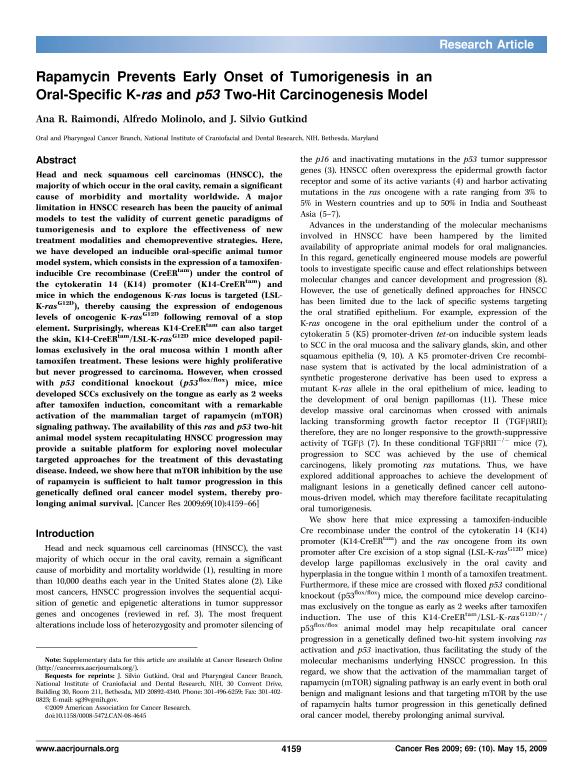Mostrar el registro sencillo del ítem
dc.contributor.author
Raimondi, Ana Rosa

dc.contributor.author
Molinolo, Alfredo

dc.contributor.author
Gutkind, Jorge Silvio

dc.date.available
2020-09-11T17:10:27Z
dc.date.issued
2009-05
dc.identifier.citation
Raimondi, Ana Rosa; Molinolo, Alfredo; Gutkind, Jorge Silvio; Rapamycin Prevents Early Onset of Tumorigenesis in an Oral-Specific K-ras and p53 Two-Hit Carcinogenesis Model; American Association for Cancer Research; Cancer Research; 69; 10; 5-2009; 4159-4166
dc.identifier.issn
0008-5472
dc.identifier.uri
http://hdl.handle.net/11336/113821
dc.description.abstract
Head and neck squamous cell carcinomas (HNSCC), the majority of which occur in the oral cavity, remain a significant cause of morbidity and mortality worldwide. Amajor limitation in HNSCC research has been the paucity of animal models to test the validity of current genetic paradigms of tumorigenesis and to explore the effectiveness of new treatment modalities and chemopreventive strategies. Here, we have developed an inducible oral-specific animal tumor model system, which consists in the expression of a tamoxifeninducible Cre recombinase (CreERtam) under the control of the cytokeratin 14 (K14) promoter (K14-CreERtam) and mice in which the endogenous K-ras locus is targeted (LSLK-rasG12D), thereby causing the expression of endogenous levels of oncogenic K-rasG12D following removal of a stop element. Surprisingly, whereas K14-CreERtam can also target the skin, K14-CreERtam/LSL-K-rasG12D mice developed papillomas exclusively in the oral mucosa within 1 month after tamoxifen treatment. These lesions were highly proliferative but never progressed to carcinoma. However, when crossed with p53 conditional knockout (p53flox/flox) mice, mice developed SCCs exclusively on the tongue as early as 2 weeks after tamoxifen induction, concomitant with a remarkable activation of the mammalian target of rapamycin (mTOR) signaling pathway. The availability of this ras and p53 two-hit animal model system recapitulating HNSCC progression may provide a suitable platform for exploring novel molecular targeted approaches for the treatment of this devastating disease. Indeed, we show here that mTOR inhibition by the use of rapamycin is sufficient to halt tumor progression in this genetically defined oral cancer model system, thereby prolonging animal survival.
dc.format
application/pdf
dc.language.iso
eng
dc.publisher
American Association for Cancer Research

dc.rights
info:eu-repo/semantics/openAccess
dc.rights.uri
https://creativecommons.org/licenses/by-nc-sa/2.5/ar/
dc.subject
oral cancer
dc.subject
Kras
dc.subject
p53
dc.subject.classification
Oncología

dc.subject.classification
Medicina Clínica

dc.subject.classification
CIENCIAS MÉDICAS Y DE LA SALUD

dc.title
Rapamycin Prevents Early Onset of Tumorigenesis in an Oral-Specific K-ras and p53 Two-Hit Carcinogenesis Model
dc.type
info:eu-repo/semantics/article
dc.type
info:ar-repo/semantics/artículo
dc.type
info:eu-repo/semantics/publishedVersion
dc.date.updated
2020-09-08T14:06:16Z
dc.journal.volume
69
dc.journal.number
10
dc.journal.pagination
4159-4166
dc.journal.pais
Estados Unidos

dc.journal.ciudad
Philadelphia
dc.description.fil
Fil: Raimondi, Ana Rosa. National Institutes of Health; Estados Unidos. Consejo Nacional de Investigaciones Científicas y Técnicas. Oficina de Coordinación Administrativa Houssay; Argentina
dc.description.fil
Fil: Molinolo, Alfredo. National Institutes of Health; Estados Unidos
dc.description.fil
Fil: Gutkind, Jorge Silvio. National Institutes of Health; Estados Unidos
dc.journal.title
Cancer Research

dc.relation.alternativeid
info:eu-repo/semantics/altIdentifier/doi/http://dx.doi.org/10.1158/0008-5472.CAN-08-4645
dc.relation.alternativeid
info:eu-repo/semantics/altIdentifier/url/https://cancerres.aacrjournals.org/content/69/10/4159
Archivos asociados
